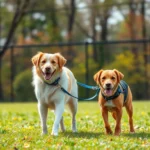
General George S. Patton is a name that resonates through the annals of military history. Known for his fearless leadership during World War II, Patton was a significant figure whose tactics and strategies left an indelible mark on military culture. Beyond the battlefield, Patton had a rich personal life, filled with interests that shaped the man behind the uniform. Among these interests was his love for animals, particularly dogs. This post seeks to answer a curious question: what breed of dog did General Patton have?
General Patton’s Love for Animals
Early Influences
From a young age, Patton was exposed to animals, particularly through the influence of his family. Growing up in a family that appreciated the outdoors and animal husbandry, his early interactions with animals fostered a lifelong passion. His upbringing in a well-off household allowed him access to various breeds of dogs, which undoubtedly contributed to his affection for them.
The Role of Pets in Patton’s Life
During his military career, Patton found companionship in his pets, which served as a source of comfort amidst the chaos of war. His letters and anecdotes often reveal the solace he derived from his dogs. In one of his famous quotes, he stated, “The more I learn about people, the more I like my dog.” This sentiment illustrates the significant role that pets played in providing companionship and emotional support throughout his life.
The Breed of Dog Owned by General Patton
Identification of the Breed
General Patton was known to have an English Bull Terrier as his beloved dog. This breed is characterized by its muscular build, distinctive egg-shaped head, and spirited personality. English Bull Terriers are known for their loyalty, intelligence, and energetic nature, making them ideal companions for someone with a vibrant personality like Patton’s.
Patton’s Dog: Names and Stories
The English Bull Terrier that Patton adored was named Willie. Willie was not just a pet but a steadfast companion who accompanied Patton during various military campaigns. Stories abound of Willie’s antics in military camps, where he would often roam freely, delighting soldiers with his playful behavior. One notable story recounts how Willie would accompany Patton during inspections, solidifying the bond between the general and his dog while also providing a sense of normalcy in an otherwise rigorous environment.
The Significance of Patton’s Dog
Symbol of Loyalty and Companionship
Willie represented more than just a pet; he was a symbol of loyalty and companionship in Patton’s life. The bond between Patton and Willie mirrored the camaraderie he valued in his military life. Just as soldiers relied on each other, Patton leaned on Willie for emotional support during the stress of war. This relationship highlighted the importance of loyalty, both in the context of military service and personal relationships.
Influence on Patton’s Image
The presence of Willie also played a crucial role in shaping Patton’s public persona. Photographs of Patton with his dog often showcased a softer side of the commanding general, which contrasted starkly with his fierce reputation on the battlefield. Media portrayals of Patton frequently included Willie, portraying the general as a man who not only led troops into battle but also cherished the bonds of friendship and loyalty that dogs provide.
The Impact of Pets on Military Figures
Historical Context
Throughout history, many prominent military figures have had pets that provided comfort and companionship during tumultuous times. From Napoleon’s greyhound to General Eisenhower’s terrier, these animals often served as a reminder of home, grounding their owners amidst the rigors of military life. The presence of pets in military settings is not merely anecdotal; it is a reflection of the human need for connection, especially during trying times.
Psychological Benefits
The psychological impact of having pets in high-stress environments, such as military service, cannot be overstated. Numerous studies suggest that animals can provide therapeutic benefits, reducing stress levels and improving overall mental health. For military personnel, having a pet like Willie could alleviate feelings of isolation and anxiety, fostering a sense of belonging and emotional stability. Experts agree that the companionship of a pet can be incredibly beneficial, particularly in the demanding reality of military life.
Legacy of General Patton and His Dog
Patton’s Legacy in History
General Patton’s contributions to World War II are well-documented, known for his aggressive tactics and unyielding leadership. His strategies helped liberate Europe and shaped modern military tactics. Beyond his battlefield achievements, Patton’s legacy also includes his charismatic leadership style and his complex personality, which encompassed both a fierce warrior and a tender-hearted pet owner.
The Legacy of Patton’s Dog
Willie’s legacy extends beyond his life with Patton. The bond they shared is often remembered in historical narratives, symbolizing the importance of companionship in the lives of military figures. The affection Patton had for Willie also sparked interest in pet ownership within military families, emphasizing the therapeutic role that pets can play in navigating the challenges of military life.
Conclusion
General Patton’s relationship with his dog, an English Bull Terrier named Willie, showcases the profound bond between humans and their pets. This connection is particularly resonant in the lives of influential figures like Patton, who balanced the weight of leadership with the need for companionship. The presence of a dog in Patton’s life served not only as a source of comfort during tumultuous times but also as a reflection of the loyalty and camaraderie that defined his military ethos. As we explore the lives of historical figures, it is essential to remember the role pets play in fostering emotional bonds, reminding us that the connection between humans and animals transcends time and circumstance.









